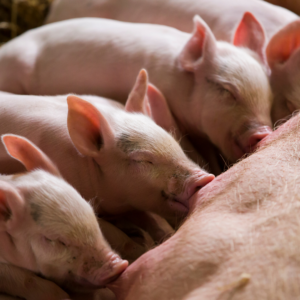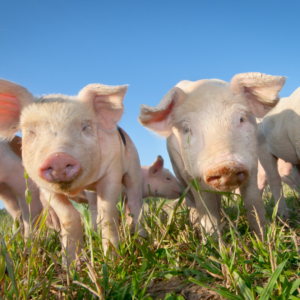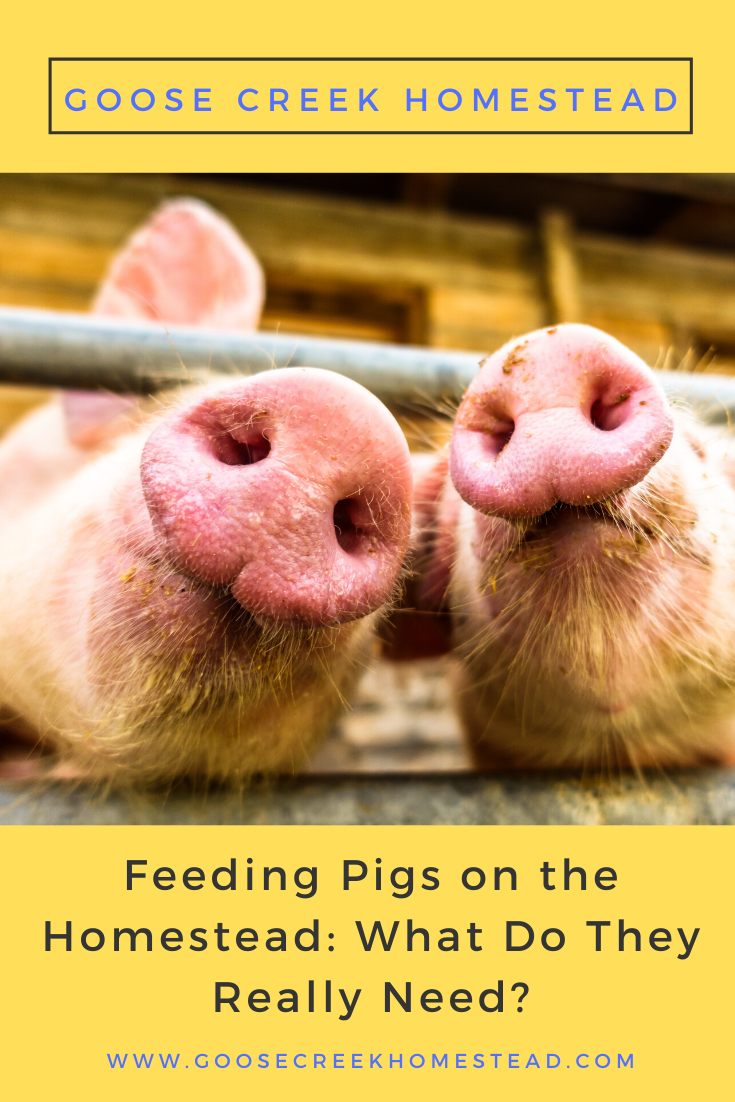Feeding pigs on the homestead doesn’t have to be expensive. Here’s how to raise pigs to fill your freezer without breaking the bank.
By now, we all know that proper nutrition is critical for not only our health but also for the health of our livestock. The question is, what are the nutritional requirements of a healthy pig?
Proper feeding is required for growth and maintenance, but it doesn’t have to be expensive. In fact, pigs can do just fine on a diet of pasture and kitchen scraps alone, without the need for further supplementation, provided they have ample amounts of each. Here’s what you need to know about feeding pigs on the homestead.

Feeding Pigs on the Homestead: The Basics of Pig Nutrition
When fed on a proper diet, pigs will grow faster, maintain their weight better, have better lactation, and reproduce more successfully. In general, a pig fed a proper diet will be healthier all around, which is good for the farmer, as well as the pig. Pigs are omnivores so they will eat both meat and plants. On pasture, they will consume grasses, roots, and even earthworms. If they are missing essential nutrients from their diet, their growth rate will be slow, and that’s not good for productivity.
Although pigs love pasture, they will need to have additional food sources to supplement their foraging. Since pigs have a single stomach, they don’t digest fiber well. They can actually only digest about 50% of the fiber in their diet, and since pasture primarily fiber, it makes sense that they would require other foods sources. It is important to provide sources of protein such as peanuts, milk, soybeans, corn, or peas. Cereal grains such as wheat or oats can be included, but they do not provide enough protein on their own, so additional protein will still need to be provided.

What to Feed Piglets
As with any other animal, the nutritional needs of piglets are different from those of adult pigs. Make sure that your newborn piglets get colostrum within 24 hours of farrowing (birth). The colostrum will provide important antibodies needed for the baby pigs’ healthy immune system.
Once your baby pigs reach three weeks of age, creep feed can be introduced to supplement the mother pig’s milk. If offered before three weeks of age, much of the feed will be wasted. Creep feeding helps the piglets develop the necessary digestive enzymes they need for digesting food sources other than milk, which also helps to make the weaning process easier.
As your piglets are weaned, they will transition from the creep feed to a grower diet that is high in lysine and other amino acids that encourage maximum growth. The grower diet is usually fed from about 50 pounds to 120 pounds. After that, the pigs are transitioned to a finisher diet.
Feeding Pregnant and Lactating Sows
Never overfeed your pregnant sows. Overfeeding can lead to problems during gestation and farrowing. During gestation, a sow should eat between four to six pounds of commercial swine feed each day. However, a lactating sow will usually consume anywhere from nine to 15 pounds of commercial swine feed per day.

What to Feed Your Adult Pigs
The nutritional needs of pigs fall into six categories: proteins, fats, carbohydrates, vitamins, minerals, and water. These feeds can all be fed to pigs:
- Although this is probably the most expensive option, there are commercially prepared swine feeds that contain a proper balance of fruits, vegetables, and grains. These may make a good option for overwintering your pigs or supplementing the diet when pasture and other free food sources are scarce. Commercial diets are also good for sows during gestation and lactation, and for young piglets, to make sure proper nutritional needs are met.
- Kitchen scraps are a great source of free food for pigs. Bread, fruit, vegetables, and even surplus milk will all provide nutritious sustenance for your
- Restaurant scraps can be another great source of free pig food. Check around with local restaurants to see if they will save all their fruit, vegetable, and bread scraps for you.
- Forage is another excellent free food for pigs. They love to root around in the pasture looking for goodies to eat.
- If there is a distillery or brewery in your area, the leftover grains from the distillation process can make excellent feed for pigs.
What Not to Feed Your Pigs of Any Age
Don’t give your pigs any meat products, fish, or animal carcasses. Although some pigs might be happy to eat meat, pigs that are fed meet risk contracting diseases that are contagious to humans when the pork is consumed.

Feeding Pigs on the Homestead Without Breaking the Bank
Generally, the average homesteader raising a couple of pigs for the freezer each year is going to be interested in feeding them as affordably as possible without sacrificing growth or meat quality. Rotating your pigs on quality forage is a great way to raise pigs inexpensively. When roaming in the pasture, pigs will eat fruits, nuts, roots, grasses, insects, and even small animals like mice.
To keep your pigs contained within the pasture, electric fencing is the most effective, and portable electric net fencing allows you to rotate them easily to a new spot every few days. Pasture rotation minimizes damage to the pasture and helps to keep both the pigs and the land healthier. Just be sure that your pigs have access to shade, some type of shelter from rain and wind, and of course fresh water at all times.
You can also let your pigs run in your garden and fields after the growing season. They will clean up any food that’s been left behind, saving you some money on pig feed. Pigs run on a cornfield at the end of the season might not even touch grain because they are so well satisfied.
The Takeaway
Feeding pigs on the homestead doesn’t have to be expensive. If you can provide plenty of food scraps and access to access to quality forage, you won’t need to provide much commercial feed at all. This is especially true if you are just raising a couple of weaner pigs to market weight. You will be butchering them in late fall so you won’t have to spend money to feed them all winter.





